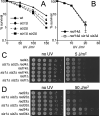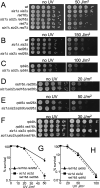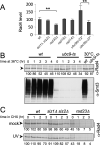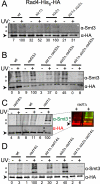A role for SUMO in nucleotide excision repair
- PMID: 21968059
- PMCID: PMC3220943
- DOI: 10.1016/j.dnarep.2011.09.013
A role for SUMO in nucleotide excision repair
Abstract
The two Siz/PIAS SUMO E3 ligases Siz1 and Siz2 are responsible for the vast majority of sumoylation in Saccharomyces cerevisiae. We found that siz1Δ siz2Δ mutants are sensitive to ultra-violet (UV) light. Epistasis analysis showed that the SIZ genes act in the nucleotide excision repair (NER) pathway, and suggested that they participate both in global genome repair (GGR) and in the Rpb9-dependent subpathway of transcription-coupled repair (TCR), but have minimal role in Rad26-dependent TCR. Quantitative analysis of NER at the single-nucleotide level showed that siz1Δ siz2Δ is deficient in repair of both the transcribed and non-transcribed strands of the DNA. These experiments confirmed that the SIZ genes participate in GGR. Their role in TCR remains unclear. It has been reported previously that mutants deficient for the SUMO conjugating enzyme Ubc9 contain reduced levels of Rad4, the yeast homolog of human XPC. However, our experiments do not support the conclusion that SUMO conjugation affects Rad4 levels. We found that several factors that participate in NER are sumoylated, including Rad4, Rad16, Rad7, Rad1, Rad10, Ssl2, Rad3, and Rpb4. Although Rad16 was heavily sumoylated, elimination of the major SUMO attachment sites in Rad16 had no detectable effect on UV resistance or removal of DNA lesions. SUMO attachment to most of these NER factors was significantly increased by DNA damage. Furthermore, SUMO-modified Rad4 accumulated in NER mutants that block the pathway downstream of Rad4, suggesting that SUMO becomes attached to Rad4 at a specific point during its functional cycle. Collectively, these results suggest that SIZ-dependent sumoylation may modulate the activity of multiple proteins to promote efficient NER.
2011 Elsevier B.V. All rights reserved.
Figures







Similar articles
-
Topoisomerase I-dependent viability loss in saccharomyces cerevisiae mutants defective in both SUMO conjugation and DNA repair.Genetics. 2007 Sep;177(1):17-30. doi: 10.1534/genetics.107.074708. Epub 2007 Jul 1. Genetics. 2007. PMID: 17603101 Free PMC article.
-
Double mutants of Saccharomyces cerevisiae with alterations in global genome and transcription-coupled repair.Mol Cell Biol. 1996 Feb;16(2):496-502. doi: 10.1128/MCB.16.2.496. Mol Cell Biol. 1996. PMID: 8552076 Free PMC article.
-
Analysis of gene- and strand-specific repair in the moderately UV-sensitive Saccharomyces cerevisiae rad23 mutant.Mutat Res. 1996 Feb 15;362(2):155-65. doi: 10.1016/0921-8777(95)00045-3. Mutat Res. 1996. PMID: 8596534
-
Facilitators and Repressors of Transcription-coupled DNA Repair in Saccharomyces cerevisiae.Photochem Photobiol. 2017 Jan;93(1):259-267. doi: 10.1111/php.12655. Epub 2016 Nov 30. Photochem Photobiol. 2017. PMID: 27796045 Review.
-
Transcription coupled nucleotide excision repair in the yeast Saccharomyces cerevisiae: The ambiguous role of Rad26.DNA Repair (Amst). 2015 Dec;36:43-48. doi: 10.1016/j.dnarep.2015.09.006. Epub 2015 Sep 10. DNA Repair (Amst). 2015. PMID: 26429063 Review.
Cited by
-
Global Identification of Small Ubiquitin-related Modifier (SUMO) Substrates Reveals Crosstalk between SUMOylation and Phosphorylation Promotes Cell Migration.Mol Cell Proteomics. 2018 May;17(5):871-888. doi: 10.1074/mcp.RA117.000014. Epub 2018 Feb 8. Mol Cell Proteomics. 2018. PMID: 29438996 Free PMC article.
-
Rad25 protein is targeted for degradation by the Ubc4-Ufd4 pathway.J Biol Chem. 2015 Mar 27;290(13):8606-12. doi: 10.1074/jbc.M114.618793. Epub 2015 Feb 10. J Biol Chem. 2015. PMID: 25670855 Free PMC article.
-
Sumoylation influences DNA break repair partly by increasing the solubility of a conserved end resection protein.PLoS Genet. 2015 Jan 8;11(1):e1004899. doi: 10.1371/journal.pgen.1004899. eCollection 2015 Jan. PLoS Genet. 2015. PMID: 25569253 Free PMC article.
-
Implication of SUMO E3 ligases in nucleotide excision repair.Cytotechnology. 2015 Aug;67(4):681-7. doi: 10.1007/s10616-014-9762-8. Epub 2014 Jul 10. Cytotechnology. 2015. PMID: 25008297 Free PMC article.
-
NRMT1 knockout mice exhibit phenotypes associated with impaired DNA repair and premature aging.Mech Ageing Dev. 2015 Mar;146-148:42-52. doi: 10.1016/j.mad.2015.03.012. Epub 2015 Apr 2. Mech Ageing Dev. 2015. PMID: 25843235 Free PMC article.
References
-
- Geiss-Friedlander R, Melchior F. Concepts in sumoylation: a decade on. Nat Rev Mol Cell Biol. 2007;8:947–956. - PubMed
-
- Thomson TM, Guerra-Rebollo M. Ubiquitin and SUMO signalling in DNA repair. Biochem Soc Trans. 2010;38:116–131. - PubMed
-
- Ulrich HD. The SUMO system: an overview. Methods Mol Biol. 2009;497:3–16. - PubMed
Publication types
MeSH terms
Substances
Grants and funding
LinkOut - more resources
Full Text Sources
Molecular Biology Databases
Research Materials
Miscellaneous

